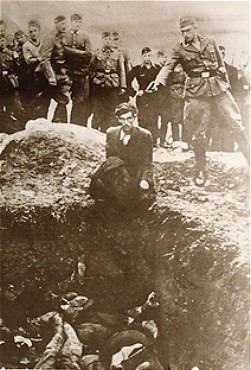On the 22nd of June 1941, German troops launched Operation Barbarossa, Germany's attack on the Soviet Union. From the point of view of the Nazis, this was not an ordinary military conflict, but a battle against the chief ideological and racial enemy of the German nation. Since the 1920s, the Nazis had declared Bolshevism to be the greatest threat to European society, and claimed that the Soviet regime was a front for a Jewish conspiracy that aimed to rule the other nations. As the Nazis penetrated into the interior of the Soviet Union, they gained control over the numerous Jewish communities that were dotted in a broad band spreading from the Baltics, across Belarus and Ukraine to the Black Sea.
At the rear of the German army were four Einsatzgruppen (link in Czech) - special units whose task was the fight against ideological opponents. They were required to kill all Communist functionaries, Jews holding party and state functions, and other radical elements
. In reality, however, the main role of these units was to massacre the Jewish communities. To begin with, only Jewish men were murdered, but soon women and children were also being killed. The largest single massacre was the execution of over 30 000 Kievan Jews in Babi Yar at the end of September 1941. It is estimated that these units, aided by local militia and in coordination with the army, slaughtered approximately 1.25 million Jews in all, as well as hundreds of thousands of other Soviet citizens.

Einsatzgruppen executing Jews in Ukraine, 1942. (Photo: Library of Congress, courtesy of USHMM Photo Archives.)
From the invasion of the Soviet Union onwards, however, the genocidal policy implemented in the occupied Soviet territories was to be extended to all Jews in the Nazi sphere of power. The decision to kill the European Jews was undoubtedly taken by spring 1941 at the latest. Himmler's SS faced a double problem, however firstly, finding a suitable and effective method of killing, and secondly, transporting the victims to the place of their death.
The Nazis experimented in their search for the most effective killing method, one which would not take such a heavy toll on the killers' psyche as the mass shootings that were carried out by the Einsatzgruppen in the conquered territories. Indeed, it was the Einsatzgruppen who in November 1941 started to use a new method of extermination - mobile gas chambers, in which the victims were killed by exhaust gas. From December 1941 on, these lethal vehicles were used in Chelmno. A total of 20 mobile gas chambers were produced.
In 1942 the already-existing concentration and labour camps in the Generalgouvernment were transformed into extermination camps, the task of which was to murder the greatest number of victims in as effective
a way as possible. Killing by gas, which had already been used in the euthanasia programme
(link in Czech), was now considered by the Nazi planners to be the most suitable way of carrying out the murder of millions of people. From the start of 1942 on, extermination centres were gradually created, equipped with permanent gas chambers. Some of the staff who had gained experience in the euthanasia
programme was now transferred to the camps designated for the mass murder of Jews, where they set up the gas chambers. In February they were installed in Bełżec, in May in Sobibor, in July in Treblinka and in Majdanek they were in operation from September 1942. These gas chambers were usually disguised as showers, and used exhaust fumes to kill. The whole operation was named Operation Reinhard, after Reinhard Heydrich, who had been assassinated by Czechoslovak parachutists in Prague on the 27th of May 1942. It did not end until the close of 1943, when the extermination camps at Bełżec, Sobibor and Treblinka were closed. In all, over 1.7 million Jews were murdered in them while they were in operation.
The chief pillar of the extermination process was the camp at Auschwitz, where between March and June 1943, four new gas chambers were built. These used the poisonous gas Zyklon B to kill. The new gas chambers were installed in the Auschwitz-Birkenau camp, founded near the original camp. Auschwitz received transports from the whole of Nazi-occupied Europe. After arriving in the camp, most of the transports went through selection
, in which the SS selected a few prisoners for forced labour, the others being sent to immediate death in the gas chambers. Those who were not murdered immediately on arrival were not to be spared, but were to be exterminated in a process known as Vernichtung durch Arbeit
- destruction through labour. These prisoners, dispersed throughout the auxiliary Auschwitz and other camps that formed the extensive system of Nazi concentration camps, were forced to engage in slave labour in inhuman conditions, leading to utter exhaustion that usually ended in death.